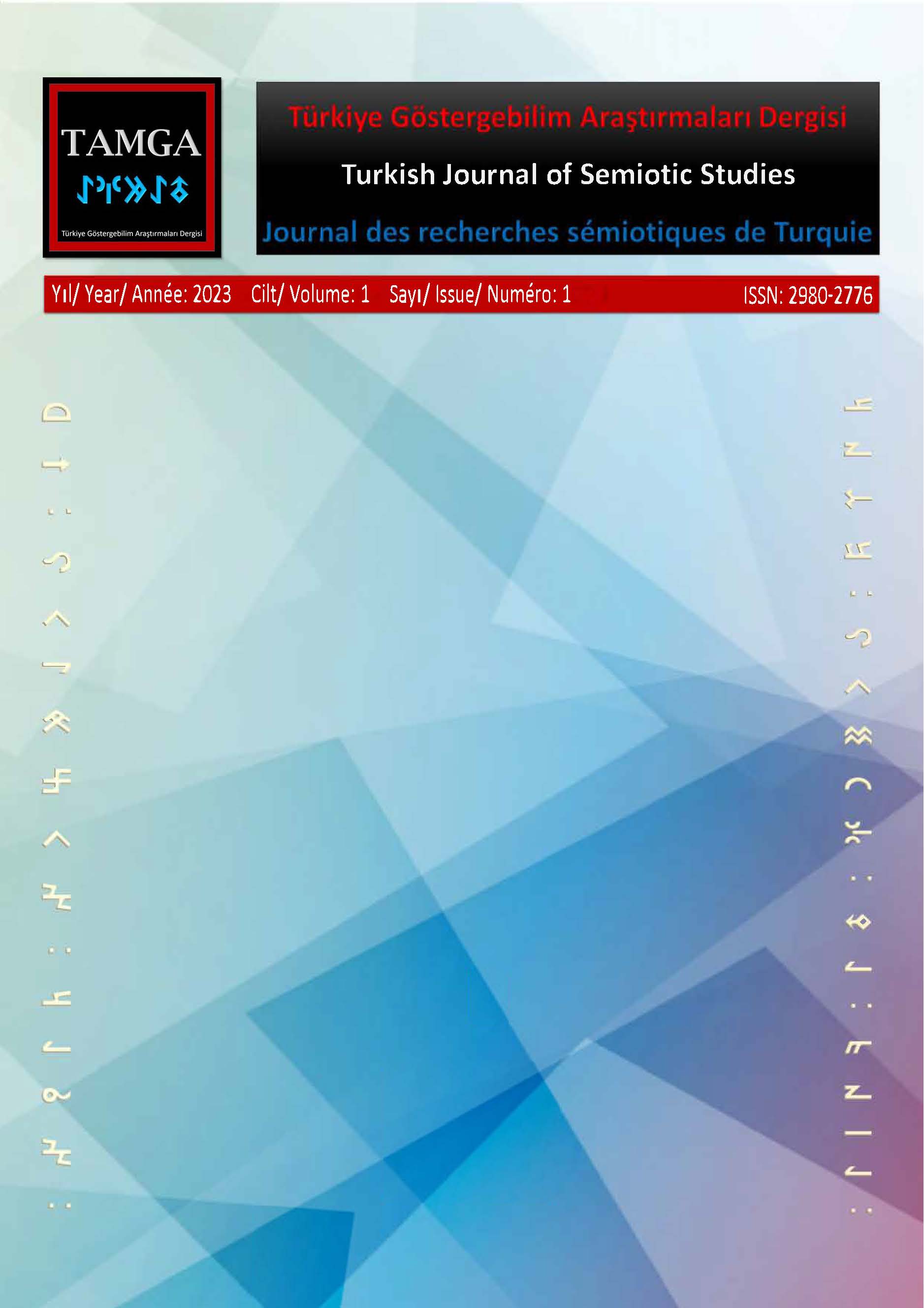Transdisciplinarity in semiotics
DOI:
https://doi.org/10.5281/zenodo.8092401Keywords:
Transdisciplinarity, discourse of semioticians, spatiality, temporality, agentivityAbstract
Semiotics is a transdisciplinary project by its very nature and from its very beginning. I will not, however, enter into a detailed discussion of the very subtle questions concerning the concept of transdisciplinarity, which should be posed in ontological-epistemological and methodological terms. In this article, however, I will attempt to evoke the positions or postures of contemporary semioticians who have devoted themselves to the development of the theoretical foundations of this science of meaning and communication, i.e., semiotics. Indeed, the central purpose of this work is to demonstrate the transdisciplinary nature of contemporary semiotics in three stages. First, I will demonstrate the status of semiotics as a transdisciplinary project by exploring the positions of some representative semioticians on the transdisciplinary nature of this discipline. Secondly, I would like to present a selection of my collective and individual projects and works, carried out over the last two decades, which can prove the transdisciplinarity of semiotics. I would say that I have accomplished a certain transdisciplinarity thanks to the semiotic spirit without knowing it, like Mr. Jourdan. Thirdly, with a view to creating new research programs in the sense of Latatos (Latatos, 1978), or exploring new fields in the sense of Kant (Kant, 1995), I would like to consider an epistemological renewal of semiotics by laying the groundwork for the five axes: spatiality, agentivity, temporality, narrativity, and sociality. It goes without saying that these axes are intimately connected. Three major events such as the Anthropocene, the Covid-19 pandemic, and artificial intelligence, have inspired me to reconceptualize the epistemological foundations of the semiotics of the future.
References
Badir, S. (2007). Pour une sémiotique indisciplinée. Association Française de Sémiotique.
Badir, S. (2022). Les pratiques discursives du savoir. Le cas sémiotique. Lambert-Lucas.
Boutaud, J.-J. & Veron, E. (2008). Sémiotique ouverte. Itinéraires sémiotiques en communication : Paris, Lavoisier coll. Forme et sens, 2007, 194.
Brier, S. (2008). Cybersemiotics: Why information is not enough! University of Toronto Press.
Brier, S. (2013). Cybersemiotics: A New Foundation for Transdisciplinary Theory of Information, Cognition, Meaningful Communication and the Interaction Between Nature and Culture. Integral Review: A Transdisciplinary & Transcultural Journal for New Thought, Research, & Praxis, 9(2).
Brier, S. (2019). Cybersemiotic Systemic and Semiotical Based Transdisciplinarity. Transdisciplinary Journal of Engineering & Science, 10, 17-30. https://doi.org/10.22545/2019/0119
Brown, V. A., Harris, J. A., & Russell, J. Y. (2010). Tackling wicked problems. In Earthscan.
Cannizzaro, S. (2014). Transdisciplinarity for the 21st century: Biosemiotics as systems theory. Cybernetics & Human Knowing, 21(3), 45-59.
Deely, J. N. (1990). Basics of semiotics (Vol. 568). Indiana University Press. Eco, U. (1979). A theory of semiotics / 1st Midland Book ed. Indiana University Press. https://library.korea.ac.kr/detail/?cid=CAT000000601396&ctype=m
Fontanille, J., & Barrier, G. (1999). Métiers de la sémiotique. Pulim.
Fontanille, J. (2017). La sémiotique de Greimas : un projet scientifique de long terme. Semiotica, 214, 91-110. https://doi-org-ssl.oca.korea.ac.kr/10.1515/sem-2016-0184
Fontanille, J., & Zinna, A. (2019). Le dialogue entre la sémiotique structurale et les sciences. Hommage à Algirdas Julien Greimas. Langages, 213, 5-16. https://oca.korea.ac.kr/link.n2s?url=https://search.ebscohost.com/login.aspx?direct=true&d=edsjsr&A N=edsjsr.26780877&lang=ko&site=eds-live&scope=site
Hébert, L. (2020). Essais de définition du sémiotique, de la sémiotique et de l’interdisciplinarité. Semiotica, 2020(234), 123-143. https://doi.org/10.1515/sem-2018-0140
Hirsch Hadorn, G., Bradley, D., Pohl, C., Rist, S., & Wiesmann, U. (2006). Implications of transdisciplinarity for sustainability research [Article]. Ecological Economics, 60(1), 119-128. https://doi.org/10.1016/j.ecolecon.2005.12.002
Jahn, T., Bergmann, M., & Keil, F. (2012). Transdisciplinarity: Between mainstreaming and marginalization. Ecological Economics, 79, 1-10. https://doi.org/10.1016/j.ecolecon.2012.04.017
Kant, I. (1995). Critique de la faculté de juger. (A. Renaut, Trans.). Flammarion.
Kesteman, J. (2004). L'Un, le Multiple et le Complexe. L'Université et la transdisciplinarité. A contrario, 2, 89-108. https://doi.org/10.3917/aco.021.108
Klinkenberg, J. M. (1996). Précis de sémiotique générale. De Boeck Université.
Lakatos, I. (1978). The methodology of scientific research programmes. Cambridge University Press.
Latour, B. (2014). Agency at the Time of the Anthropocene. New literary history, 45(1), 1-18.
Latour, B., & Lemonde, F. (2014). L'Anthropocène et la destruction de l'image du Globe.
Hadorn, G. H., Biber-Klemm, S., Grossenbacher-Mansuy, W., Hoffmann-Riem, H., Joye, D., Pohl, C., Wiesmann, U., & Zemp, E. (2008). The emergence of transdisciplinarity as a form of research. Handbook of transdisciplinary research, 19-39.
Hébert, L. (2020). Essais de définition du sémiotique, de la sémiotique et de l’interdisciplinarité. Semiotica, 234, 123-143.
Hirsh, H., Bradley, D., Pohl, C., Rist, S., & Wiesmann, U. (2006). Implications of transdisciplinarity
for sustainable research. Ecological Economics, 60(1), 119-128.
Maniglier, P. (2021). Problem and Structure: Bachelard, Deleuze and Transdisciplinarity. Theory, Culture & Society, 38(2), 25-45. https://doi.org/10.1177/0263276419878245
Morin. E. (2020). Sur l'interdisciplinarité. CIRET. https://ciret-transdisciplinarity.org/bulletin/b2c2.php
Petitimbert, J. P. (2017). Anthropocenic Park: humans and non-humans in socio-semiotic interaction. Actes Sémiotiques, 120, 1-12.
Pohl, C. (2007). Principles for designing transdisciplinary research. Oekom Verlag GmbH.
Posner, R. (2003). 123. The relationship between individual disciplines and interdisciplinary approaches 13(3). De Gruyter. https://doi.org/10.1515/9783110194159-001
Rastier, F. (2001). Sémiotique et sciences de la culture. Linx. Revue des linguistes de l’université Paris X Nanterre, (44), 149-168.
Rastier, F. (2009). Sémantique interprétative. Presses universitaires de France.
Rastier, F. (2010). Objets culturels et performances sémiotiques. L’objectivation critique dans les sciences de la culture. Louis Hébert & Lucie Guillemette (dirs.), Performances et objets culturels. Nouvelles perspectives, 15-58.
Renn, O. (2021). Transdisciplinarité : Synthèse vers une approche modulaire. Futures, 130, 3-8. Resweber, J.-P. (1981). La Méthode interdisciplinaire. Presses Universitaires de France. https://doi.org/10.3917/puf.reswe.1981.01
Scholz, R. W., & Steiner, G. (2015). Transdisciplinarity at the crossroads. Sustainability Science, 10(4), 521-526. https://doi.org/https://doi.org/10.1007/s11625-015-0338-0
Sebeok, T. A. (1994). An introduction to semiotics. Pinter.
Vidales, C. & Brier. S. (Eds.). (2021). Introduction to Cybersemiotics: A Transdisciplinary Perspective. Springer.
Downloads
Published
How to Cite
Issue
Section
License
Copyright (c) 2023 Sung Do KIM

This work is licensed under a Creative Commons Attribution 4.0 International License.



